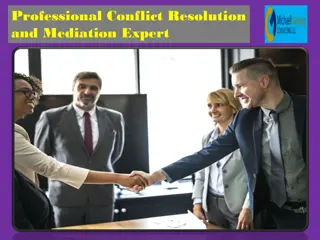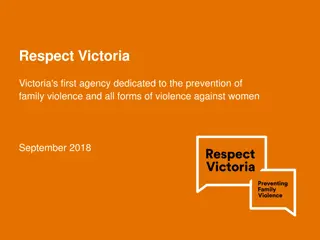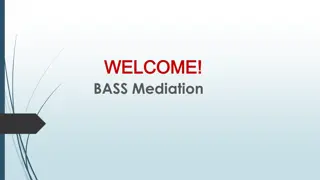Evolution of Mediation in Victoria: A Historical Overview
Mediation in Victoria has evolved significantly over the years, starting in the mid-80s primarily for building disputes and expanding to a wider audience. The Law Institute of Victoria played a crucial role in accrediting ADR specialists, supported by the state government. Court-ordered mediation became a common practice, emphasizing the importance of appropriate dispute resolution processes. The historical journey culminated in a comprehensive report in 2009 titled "Mediation in the Supreme and County Courts of Victoria."
Download Presentation

Please find below an Image/Link to download the presentation.
The content on the website is provided AS IS for your information and personal use only. It may not be sold, licensed, or shared on other websites without obtaining consent from the author.If you encounter any issues during the download, it is possible that the publisher has removed the file from their server.
You are allowed to download the files provided on this website for personal or commercial use, subject to the condition that they are used lawfully. All files are the property of their respective owners.
The content on the website is provided AS IS for your information and personal use only. It may not be sold, licensed, or shared on other websites without obtaining consent from the author.
E N D
Presentation Transcript
XV AIDA World Congress Rio De Janeiro October 11th-13th 2018 Civil Liability and Dispute Resolution Working Party Meeting Mediation An essential part of common law litigation in Australia A Victorian perspective Chris Rodd Mediation& Insurance Law September 2018
.. A brief history Mediation as a process for the resolution of disputes first appeared in Victoria ,the mid 80 s. It was utilised primarily in the County Court for Building Disputes. With the gradual building up of the back log of cases in the Supreme Court the then Chief Justice Phillips, introduced the notion of mediation pro bono . It was successful in its achieving its primary aim. However it achieved another key success in that it introduced mediation to a wider audience.
.. Continued success In the early 90 s the Law Institute of Victoria( LIV) , through its Specialisation Accreditation Scheme, established a category of practitioners accredited as ADR Specialists. In so doing the LIV was endorsing the need for practitioners to adopt a more flexible approach to dispute resolution. A similar approach was being taken in NSW. ADR also enjoyed the support of the then Victorian State Government. The Victorian State Attorney Generals Law Reform Advisory Council and the Law Foundation , published Standards for Court Connected Mediation in Victoria .
Court ordered mediation You can lead a horse to water At any one of the Directions Hearings the Court may direct the parties to mediation before listing the case for trial . ( Supreme Court Rules r 50.07) ( County Court Rules rr 34A.21, 50.07 ) ( Magistrates Court Act 1989(Vic), s 108(1)) . The Civil Procedure Act commenced 1/1/2011 with one of its stated purposes is to provide for the further enhancement of appropriate dispute resolution processes which includes mediation. If a party fails to attend a court ordered mediation, the party not attending may be ordered to pay the costs thrown away by non attendance ( Kullilli People v Queensland [1999] FCA1449 ). . But you can t make it drink. The parties cannot be forced to settle !
Sometimes we get a little desperate to achieve resolution .
The 2009 Report Then , in 2009 we saw the publication of an expansive 264 page report titled .. Mediation in the Supreme and County Courts of Victoria . It was commissioned by The Victorian Dept of Justice and undertaken by Prof Tania Sourdin of the Australian Centre of Peace and Conflict Studies of the University of Queensland. . A few key findings from a sample size of 553 cases . 25% of mediations resolved complex disputes that would otherwise have proceeded to a full hearing. At least ,43% of surveyed respondents reported dispute resolved, at mediation. Mediation narrowed the issues in dispute. Disputes over land ( N13) 77% settled . Property (N4)- 67% settled
2009 Report the good and the not so good Mediators reported 45% resolution rate with up to 65% as a result of post mediation negotiations. Mediators reported that in 82% of mediated cases the process saved costs median savings reported by mediators - $50,000. Parties who had matter settled at mediation reported moderate to high levels of satisfaction with process -81% ( n 30 out of 37) on the down side, 67 % of those who settled at mediation felt pressured to settle (n24 of 36). In the case of personal injury matters the parties ( particularly the plaintiffs) felt disempowered and were often not involved at all, .
not so good The process was of short duration often less than 2 hours. Negotiation was compromisory or competitive. Less than half the mediators appeared to follow any industry standard model. A significant proportion did not hear from the parties in the opening statements ( in 88% the lawyers made the opening statements ) 47% of cases private sessions were commenced immediately after opening statements. 47% stated they did not feel comfortable with the process. 59% stated they would like to have greater participation.
so how successful is mediation in the resolution of litigated disputes ? Unfortunately we don t really know other than anecdotal evidence. The Supreme Courts , County Courts and Magistrates Courts, do not maintain any data. The Courts relay on the mediators to report outcomes but many don t. Nor do many of the mediators file the necessary paperwork. The Courts currently have no reporting mechanism or data collection process . Nor, I am told, are there plans to do so. While all the courts encourage mediation and indeed in many cases direct the parties to mediation, they do not monitor outcomes.
a few personal observations The formal mediation process in personal injury litigation is very rarely observed and usually , only in part. There seems undue haste to get it done . Mediations frequently conducted in less than 2 hours. Many barristers representing the parties seem disinclined to settle on the basis that they are preparing to receive a brief for trial ! The plaintiff seems to be increasingly marginalised in the process and seems to play little part in the process . It is the lawyers mediation. I suspect that no win no fee may influence the interaction between the plaintiff and their legal advisors in the mediation process.
My observations I agree with many of the findings of the Victorian Supreme Court Report of 2009. The system has become a victim of its own success . So many mediations, that the process is rushed and has become mechanical to the point that many participants are simply going through the process with little interest in outcome. Many mediators seem little interested in following up the parties after an unsuccessful mediation, to explore possibilities for resolution. In the case of Barristers , it is probably not difficult to conclude why ! The mediation is sometimes not a mediation , but an evaluation meeting a chance to explore the weakness/strength in the other sides case and with little interest in, resolution.
The pressure on then plaintiff to settle .? The man who pays the piper , calls the tune. I suspect that the no win no fee arrangement can be used as a lever to pressure plaintiffs to settle. To what extent does the plaintiffs lawyer use the threat of withdrawl of representation to pressure the plaintiff to settle at mediation ? The Plaintiff has no interaction with the defendant s insurer or the defendants legal team. Usually the interaction is confined to meeting the mediator. This alone is contrary to standard mediation practice.
The potential cost savings against trial costs are considerable In personal injury matters Senior Counsel charge between $6,600 - $9500 per day. In Commercial litigation Senior Counsel charge between $6,600 - $12,000 per day. Junior counsel charge 50% of Senior Counsels fees and Senior Counsel rarely appear with a junior accordingly the range of fees for a trial for Counsel is $9,900 - $18,000 (for one party alone). If a Junior is appearing alone the range is $3000- $4500 ( one party ) . Does not include solicitors daily fee as instructor of $2500 - $3200. For Arbitrations Counsel generally charge ,approximately $11,000 per day. None of these costs include those of professional witnesses Medical ,accounting engineering etc
Not surprisingly, trials are expensive. Each of the costs previously mentioned are those of one side. In personal injury matters there will always be at least one defendant and in commercial matters often multiple defendants. Professional witness fees can dramatically add to trial costs. It is not uncommon for personal injury trials to occupy 8 10 sitting days in cases with substantial verdict potential. Trial costs can easily be $25,000 to $30,000 a day even with only 2 parties. Obviously the more parties involved the greater the costs. Accordingly a half day mediation with a mediator charging $2500 , represents a very substantial saving on trial costs ( $4000 for a full day ) .
CONCLUSION -The reasons to mediate ! The most obvious is cost saving ! Time saving particularly if early in the litigation process. Less stressful for all parties than a trial litigation is , by its nature confrontational. The parties negotiate and agree upon a settlement not the mediator. A greater opportunity for a win /win solution for all parties as mediation invariably requires compromise. It is not a verdict .It is an agreed solution . If the parties cannot resolve though mediation, they still have the option of a trial. Mediation usually results in narrowing the issues in dispute. Mediation is usually a voluntary step in the litigation process.























